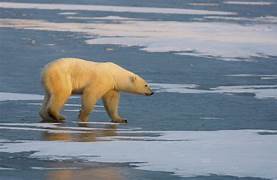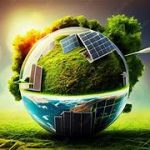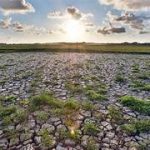Evaluating the Implications of Global Warming on Arctic Wildlife
Global warming, driven by the emission of greenhouse gases into the atmosphere, is having a profound and lasting impact on ecosystems around the world. One of the most sensitive and vulnerable areas to climate change is the Arctic. Known for its cold, icy conditions and unique biodiversity, the Arctic is home to a range of species adapted to extreme environments. However, rising temperatures, shifting ecosystems, and melting ice are threatening the delicate balance of this region. This article will evaluate the implications of global warming on Arctic wildlife, examining the effects on habitat, species survival, migration patterns, and the broader ecosystem.
The Arctic: A Region on the Brink
The Arctic is experiencing the effects of global warming more intensely than other regions of the planet. According to the Intergovernmental Panel on Climate Change (IPCC), the Arctic is warming at a rate roughly twice as fast as the global average, a phenomenon known as Arctic amplification. This rapid warming is causing the ice cap to melt at unprecedented rates, affecting everything from local weather patterns to the livelihoods of species that depend on the cold, icy environment.
The region is home to a diverse array of wildlife, including iconic species like polar bears, seals, whales, and migratory birds. However, these species are facing increasingly hostile conditions due to the changing climate. Rising temperatures, melting sea ice, changes in prey availability, and altered migration patterns are all contributing to the disruptions Arctic wildlife is currently experiencing.
Melting Ice: The Primary Threat
One of the most significant and visible impacts of global warming in the Arctic is the melting of sea ice. As temperatures rise, the Arctic’s ice sheets and sea ice are retreating, reducing the area available for ice-dependent species. For example, polar bears, which are emblematic of the Arctic ecosystem, rely on sea ice to hunt for seals. The ice provides a platform from which they can access their primary food source—ringed and bearded seals. As the ice melts earlier in the spring and forms later in the fall, polar bears are forced to travel farther and expend more energy to find food, resulting in lower survival rates, particularly for cubs.
Similarly, the loss of ice affects other species like walruses, which use the ice to haul out and rest. Without sufficient ice, large groups of walruses are being forced to congregate on land, where overcrowding can lead to dangerous stampedes, particularly for calves. Additionally, ice loss affects the entire food web of the Arctic. Algae that grow on the underside of the ice provide a crucial food source for plankton, which in turn supports fish, seals, and other marine life. As ice cover decreases, this foundational food source diminishes, further impacting species that rely on it.
Shifting Habitats and Migration Patterns
As the Arctic warms, species that have evolved to thrive in this cold, stable environment are finding it increasingly difficult to survive. The melting of sea ice is not only a physical loss of habitat for ice-dependent species, but it is also altering the landscape of the Arctic in ways that disrupt migration patterns and food availability.
For example, caribou and reindeer, which are key herbivores in the Arctic tundra, rely on the availability of lichen, moss, and grasses, which grow in the colder climates. As temperatures rise, the tundra is experiencing changes in plant composition, with shrubs and trees moving into areas previously dominated by grasses and mosses. This shift in vegetation disrupts the food sources of caribou, leading to lower reproduction rates and declining populations in some regions.
Moreover, warmer temperatures are also affecting the timing of migration for many Arctic species. Many migratory birds, such as the Arctic tern, rely on precise seasonal cues to time their journeys. As the climate warms, these birds may arrive too early or too late to access the food they need, leading to challenges in successful breeding. Similarly, animals like the caribou and polar bear are facing difficulty in aligning their migration with the availability of food due to altered seasonal patterns.
The Impact on Marine Life
The Arctic’s marine ecosystems are facing significant disruption due to warming temperatures. As the sea ice melts and retreats, it opens up new areas for human activity, such as shipping, oil drilling, and fishing. These activities not only contribute to further warming through the release of greenhouse gases but also put stress on marine species through pollution, noise, and the potential for oil spills.
Marine species like the beluga whale and narwhal, which rely on the icy waters to breed and feed, are facing increasingly unstable conditions. With melting ice, these animals are forced to adapt to changing conditions, often leading to increased competition for food and reduced access to traditional hunting grounds.
One of the most significant concerns for marine life is the loss of sea ice as a habitat for polar bears, seals, and other ice-dependent species. Seals, such as the ringed seal, are particularly vulnerable to habitat loss as they use sea ice to haul out, give birth, and raise their pups. Without adequate ice, they must rely on land, where they are more susceptible to predators and less likely to successfully raise their young. Furthermore, the disappearance of sea ice affects the primary productivity of the ocean, as ice plays a crucial role in the nutrient cycling that supports marine life.
The Changing Food Web and Ecosystem Dynamics
The impacts of global warming on Arctic wildlife are not confined to individual species; the entire ecosystem is undergoing significant changes. Warmer temperatures are altering the structure of the food web, with consequences for species at all levels. As sea ice melts, primary producers, such as algae and phytoplankton, are being impacted by the reduced availability of ice. These microscopic organisms are the foundation of the Arctic food web, supporting a wide range of marine life, from tiny zooplankton to large fish and marine mammals.
As the ice diminishes, it disrupts the process of nutrient cycling, which can lead to changes in the abundance and distribution of species that rely on these primary producers. In turn, predators that depend on these species for food are also affected. Polar bears and seals, for example, depend on fish, which rely on plankton, which in turn depends on algae. This delicate chain of interactions is being upended by the rapid pace of warming in the Arctic.
In addition to the impacts on marine ecosystems, terrestrial food webs are also facing disruptions. As the Arctic tundra warms and the composition of plants changes, herbivores like caribou may find their food sources dwindling, while predators like wolves may struggle to adapt to shifting prey populations. These cascading effects threaten the stability of the entire ecosystem, making it more vulnerable to further change and collapse.
Human Activities and Arctic Wildlife
In addition to the direct effects of climate change, human activities in the Arctic are exacerbating the challenges faced by wildlife. Increased shipping traffic, oil exploration, and mining are disturbing critical habitats and increasing pollution in the region. Oil spills, noise pollution, and the disruption of migratory paths and breeding areas are additional threats to Arctic species. Furthermore, the potential for greater human encroachment into previously untouched regions of the Arctic means that wildlife will face even greater pressures in the future.
The Arctic is also experiencing increasing tourism, particularly as ice melts and new routes open up. While tourism itself is not inherently harmful, unregulated or poorly managed tourism can lead to habitat destruction, pollution, and disturbances to wildlife. Ensuring that human activity in the Arctic is sustainable and responsible is crucial to protecting the delicate balance of this ecosystem.
The Road Ahead: Adaptation and Conservation
Despite the severe challenges posed by global warming, there is still hope for Arctic wildlife. Conservation efforts focused on habitat protection, species monitoring, and reducing human impact are essential to mitigating the effects of climate change. Marine protected areas (MPAs) and land-based conservation efforts can help shield critical habitats from human exploitation and provide safe spaces for wildlife to thrive.
Additionally, mitigating climate change itself by reducing global greenhouse gas emissions remains the most important strategy for preserving the Arctic ecosystem. International cooperation, particularly through agreements like the Paris Climate Agreement, is essential to limiting global warming and protecting vulnerable ecosystems worldwide, including the Arctic.
Moreover, the resilience of Arctic wildlife should not be underestimated. While many species face immediate threats, some have demonstrated an impressive ability to adapt to environmental changes. However, the speed and scale of climate change mean that these species will need continued support and monitoring to ensure their survival.
Conclusion: A Call for Urgent Action
The implications of global warming on Arctic wildlife are profound and far-reaching. The melting of sea ice, changes in migration patterns, and disruptions to food webs are just a few of the many consequences faced by Arctic species. The region is warming at an alarming rate, and species that have adapted to these cold environments are struggling to cope with the rapidly changing conditions.
The survival of Arctic wildlife depends on a combination of conservation efforts, climate change mitigation, and international cooperation. Without urgent action to curb greenhouse gas emissions and protect critical habitats, the future of Arctic species remains uncertain. The time to act is now, not only for the Arctic’s wildlife but for the health of the planet as a whole.


